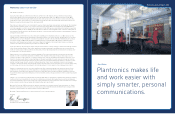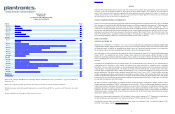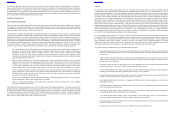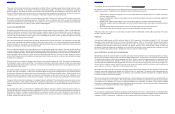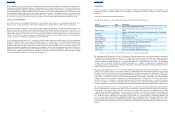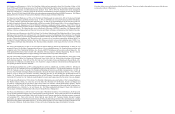Plantronics 2012 Annual Report Download - page 13
Download and view the complete annual report
Please find page 13 of the 2012 Plantronics annual report below. You can navigate through the pages in the report by either clicking on the pages listed below, or by using the keyword search tool below to find specific information within the annual report.
The failure of our suppliers to provide quality components or services in a timely manner could adversely affect our results of
operations.
Our growth and ability to meet customer demand depends in part on our ability to timely obtain raw materials, components, sub-
assemblies, and products from our suppliers. We buy raw materials, components and sub-assemblies from a variety of suppliers
and assemble them into finished products. We also have certain of our components and products manufactured for us by third
party suppliers. The cost, quality, and availability of such goods are essential to the successful production and sale of our products.
Obtaining raw materials, components, sub-assemblies, and finished products entails various risks, including the following:
• Rapid increases in production levels to meet unanticipated demand for our products could result in higher costs for
components and sub-assemblies, increased expenditures for freight to expedite delivery of required materials, and higher
overtime costs and other expenses. These higher expenditures could reduce our profit margins. Further, if production
is increased rapidly, there may be decreased manufacturing yields, which may also reduce our margins.
• We obtain certain raw materials, sub-assemblies, components and products from single suppliers, including a majority
of our Bluetooth products from GoerTek, Inc. Alternate sources for these items may not be readily available or at acceptable
prices. Any failure of GoerTek or our other suppliers to remain in business, provide us with the quantity of components
or products that we need or purchase the raw materials, subcomponents and parts required to produce and provide to us
the components or products we need could materially adversely affect our business, financial condition and results of
operations.
• Although we generally use standard raw materials, parts and components for our products, the high development costs
associated with existing and emerging wireless and other technologies may require us to work with a single source of
silicon chips, chip-sets or other components or materials (“components or materials”) on any particular product. We, or
any of our suppliers of components or materials, may experience challenges in designing, developing and manufacturing
components or materials using these new technologies which could affect our ability to meet market schedules. Our
components or materials suppliers may decide for commercial reasons to discontinue components or materials that we
have designed into our products or may cease doing business completely due to adverse economic conditions or otherwise.
Due to our dependence on single suppliers for certain components or materials, we could experience higher prices, a
delay in development of the components or materials, be forced to redesign or end of life products, make large last-time
buys which are held in inventory for extended periods of time or be unable to meet customer demand for these products.
If this occurs, our business, financial condition and results of operations could be materially adversely affected as a result
of these factors.
• Because of the lead times required to obtain certain raw materials, sub-assemblies, components and products from certain
suppliers, we may not be able to react quickly to changes in demand, potentially resulting in either excess inventories of
such goods or materials, sub-assemblies, components and product shortages. Lead times are particularly long on silicon-
based components incorporating radio frequency and digital signal processing technologies and such components make
up an increasingly larger portion of our product costs. In particular, many consumer product orders have shorter lead
times than the component lead times, making it increasingly necessary to carry more inventory in anticipation of those
orders, which may not materialize. Failure to synchronize the timing of purchases of raw materials, sub-assemblies,
components and products to meet demand could increase our inventories and/or decrease our revenues and could materially
adversely affect our business, financial condition and results of operations.
• We buy most of our raw materials, components and subassemblies on a purchase order basis and do not have long-term
commitments from our suppliers as to price or supply. Prices for many commodities are rising and are increasing our
costs. Additionally, if our suppliers experience increased demand or shortages, it could affect the timeliness of deliveries
to us. Any such shortages or further increases in prices could materially adversely affect our business, financial condition,
and results of operations.
• As part of the Dodd-Frank Wall Street Reform and Consumer Protection Act, the U.S. Securities and Exchange
Commission ("SEC") has proposed disclosure requirements regarding the use of certain minerals, known as conflict
minerals, which are mined from the Democratic Republic of Congo and adjoining countries, as well as procedures
regarding a manufacturer's efforts to prevent the sourcing of such minerals and metals produced from those minerals.
The implementation of these requirements could affect the sourcing and availability of metals used in the manufacture
of a limited number of raw material parts contained in our products. For example, the implementation of these disclosure
requirements may decrease the number of suppliers capable of supplying our needs for certain metals, thereby negatively
affecting our ability to obtain products in sufficient quantities or at competitive prices. Our material sourcing is broad
based and multi-tiered, and we may not be able to conclusively verify the origins for all metals used in our products.
Table of Contents
1514
If we do not match production to demand, we may lose business or our gross margins could be materially adversely affected.
Our industry is characterized by technological changes, frequent new product introductions, short-term customer commitments
and changes in demand. We determine production levels based on our forecasts of demand for our products. Actual demand for
our products depends on many factors, which makes it difficult to forecast. In view of the uncertainties inherent in the recovery
from the global recession, including the pace and scale of the recovery, it is particularly difficult to make accurate forecasts in this
business environment. Significant unanticipated fluctuations in product supply or demand could cause operating problems. For
example, if forecasted demand does not develop, we could have excess inventory and capacity. We have experienced differences
between our actual and our forecasted demand in the past and expect differences to arise in the future.
Some of our products utilize long-lead time parts which are available from a limited set of vendors. The combined effects of
variability of demand among our customer base with significant long-lead time of single sourced materials has in the past contributed
to significant inventory write-downs, particularly in inventory for consumer products. For OCC products, long life-cycles
periodically necessitate last-time buys of raw materials that may be used over the course of several years. We routinely review
inventory for usage potential, including fulfillment of customer warranty obligations and spare part requirements, and we write
down to market value the excess and obsolete inventory, which may have an adverse effect on our results of operations.
From time to time, we or our competitors may announce new products, capabilities, or technologies that may replace or shorten
the life cycles of our products or cause customers to defer or stop purchasing our products until new products become available.
Additionally, the announcement of new products may incite customers to increase purchases of successful legacy products as part
of a last time buy strategy; thereby increasing sales in the short-term while decreasing future sales by delaying consumer adoption
of new products. These inherent risks transitioning to new products increase the difficulty of accurately forecasting demand for
discontinued products as well as demand and acceptance for new products. Accordingly, we must effectively manage inventory
levels to have an adequate supply of the new product and avoid retention of excess legacy product; however, we must also
concurrently maintain sufficient levels of older product inventory to support continued sales during the transition. Our failure to
effectively manage transitions from old products to new could result in inventory obsolescence, and/or loss of revenue and associated
gross profit, which may further result in one or more material adverse effect on our revenues and profitability.
Over-forecast of demand could result in higher inventories of finished products, components, and sub-assemblies. In addition,
because our retail customers have pronounced seasonality, we must build inventory well in advance of the December quarter in
order to stock up for the anticipated future demand. If we are unable to sell these inventories, we would have to write off some
or all of our inventories of excess products and unusable components and sub-assemblies. Conversely, if we are unable to deliver
products on time to meet the market window of our retail customers, we will lose opportunities to increase revenues and profits,
we may incur penalties for late delivery and we may be unable to later sell the excess inventory.
Any of the foregoing problems could materially and adversely affect our business, financial condition, and results of operations.
We have strong competitors and expect to face additional competition in the future. If we are unable to compete effectively,
our results of operations may be adversely affected.
All of our markets are intensely competitive. We could face pressure on our average selling prices, competition on sales terms
and conditions, or competition with respect to performance, technical and feature enhancements from our competitors. Also,
aggressive industry pricing practices may result in downward pressure on margins.
Currently, our single largest competitor is GN Store Nord A/S (“GN”), a Danish telecommunications conglomerate with whom
we experience price competition in the business markets. Motorola is a significant competitor in the consumer headset market,
primarily in the mobile Bluetooth market, and has a brand name that is very well known and supported with significant marketing
investments. Motorola also benefits from the ability to bundle other offerings with its headsets. We are also experiencing
competition from other consumer electronics companies that currently manufacture and sell mobile phones or computer peripheral
equipment. These competitors generally are larger, offer broader product lines, bundle or integrate with other products'
communications headset tops and bases manufactured by them or others, offer products containing bases that are incompatible
with our headset tops and have substantially greater financial, marketing and other resources.
Table of Contents



